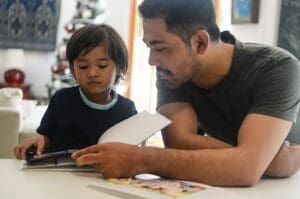Understanding the paths to literacy can be a complex journey, especially when diving into different methods and strategies. Three fundamental concepts often come up: the science of reading, structured literacy, and the Orton-Gillingham approach. Each one tackles the challenges of reading differently, but they share one key goal – promoting effective reading skills.
The ‘Science of Reading’ represents a rich, evidence-based body of research that illuminates how individuals acquire reading skills (Castles et al., 2018). Emphasizing systematic, explicit instruction in areas such as phonemic awareness, phonics, vocabulary development, reading fluency, and reading comprehension strategies, the science of reading emphasizes that reading is not a natural process that occurs through exposure alone. Particularly for those with reading challenges like dyslexia, explicit instruction is necessary (Seidenberg, 2017).
Structured Literacy is a term that encompasses instruction which is systematic, explicit, and diagnostic. It focuses on phonemic awareness, systematic phonics, and other language structures (Birsh & Carreker, 2018). Notably, Structured Literacy is diagnostic. The teacher monitors student performance, adjusting instruction based on the student’s needs. This creates a dynamic cycle of instruction and assessment (Moats, 2010).
The Orton-Gillingham approach is a form of structured literacy instruction, developed from the work of Dr. Samuel T. Orton and Anna Gillingham.. While originally designed to address the specific needs of individuals with dyslexia, the Orton-Gillingham approach’s adaptable nature makes it a powerful tool for fostering positive literacy outcomes in all learners, regardless of their abilities or challenges. By incorporating multisensory techniques and personalized instruction, it promotes a comprehensive and inclusive learning experience that benefits students of diverse backgrounds.The defining strength of the Orton-Gillingham approach lies in its multisensory philosophy, using sight, hearing, touch, and movement to facilitate reading, spelling, and writing learning (Ritchey & Goeke, 2006).
The science of reading informs us of best practices based on research, and structured literacy provides a more specific instructional framework, with the Orton-Gillingham approach further specifying the methodology with a multisensory approach (Birsh & Carreker, 2018). Each, in its way, has been significantly influenced by dyslexia research and aims to improve reading outcomes for dyslexic learners.
The Science of Reading, Structured Literacy, and the Orton-Gillingham approach represent interconnected facets of a broader literacy instruction panorama. These methodologies, supported by reliable empirical evidence, provide a comprehensive, robust framework for reading instruction. They allow educators and parents to create systematic, diagnostic, and multisensory reading strategies, thus paving the way for every child to become a proficient reader.
Works Cited:
Birsh, J. R., & Carreker, S. (2018). Multisensory teaching of basic language skills. Baltimore, MD: Paul H. Brookes Publishing Co.
Castles, A., Rastle, K., & Nation, K. (2018). Ending the Reading Wars: Reading Acquisition From Novice to Expert. Psychological Science in the Public Interest, 19(1), 5–51.
Moats, L. (2010). Speech to Print: Language Essentials for Teachers. Baltimore, MD: Paul H. Brookes Publishing Co.
Ritchey, K. D., & Goeke, J. L. (2006). Orton-Gillingham and Orton-Gillingham-Based Reading Instruction: A Review of the Literature. The Journal of Special Education, 40(3), 171–183.
Seidenberg, M. (2017). Language at the Speed of Sight: How We Read, Why So Many Can’t, and What Can Be Done About It. New York, NY: Basic Books.






